How do you do a post-mortem examination on a whale?
- Published
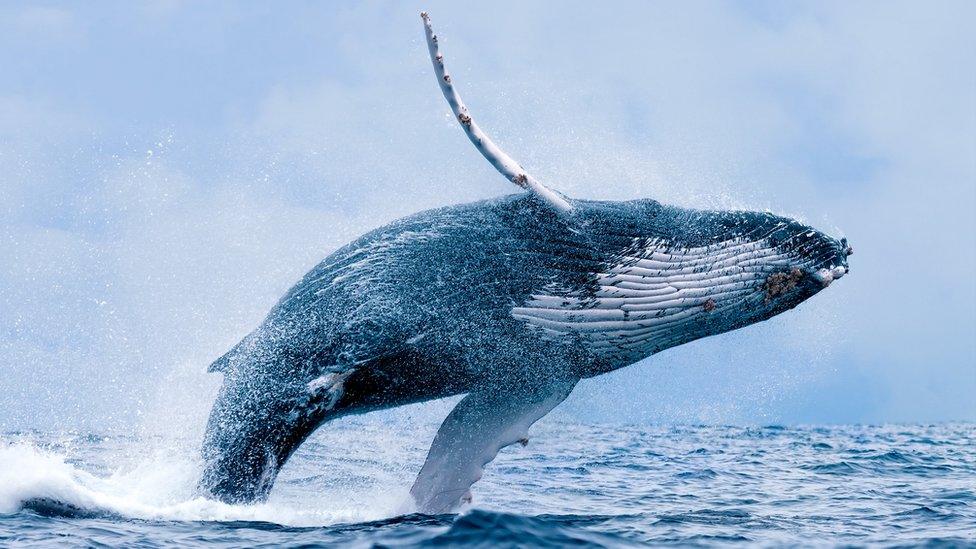
The "stranding paradox": Marine biologists say occasional stranding reports of humpback whales is a good thing because it shows population levels are improving
Scalpels, the gleam of a stainless steel worktop and the recording microphone dangling from the ceiling - the scene of a post-mortem examination is all too familiar with fans of modern crime drama. But how (and why) do you carry out a post-mortem examination on a whale?
The squeamish may not want to read further.
Warning issued, now for some figures: Each year there are about 600 reported cetacean (whales, porpoises and dolphins) strandings across Britain, of which about half are reported in England with Scotland accounting for most of the rest.
Of these annual strandings, between 100 and 150 will be subject to a post-mortem examination by the Cetacean Strandings Investigation Programme (CSIP).
One such case was reported just a few weeks ago by Sarah Henderson, who spotted a 42ft (13m) fin whale as it was being washed ashore at Holkham in Norfolk.
Ms Henderson, the conservation manager at the Holkham Estate, said while seeing a dead whale was sad it was also "fascinating".
"You just don't usually get a chance to see whales up close. I was amazed to see that, up close, this whale had whiskers on its lower jaw.
"Of course it would have whiskers, it is a mammal, but that never occurred to me.
"And the one we reported was a young whale. Fully grown it would be twice as big - that is really something."
In England, responsibility for cetacean post-mortem examinations - including the Holkham case - falls to scientist Rob Deaville.
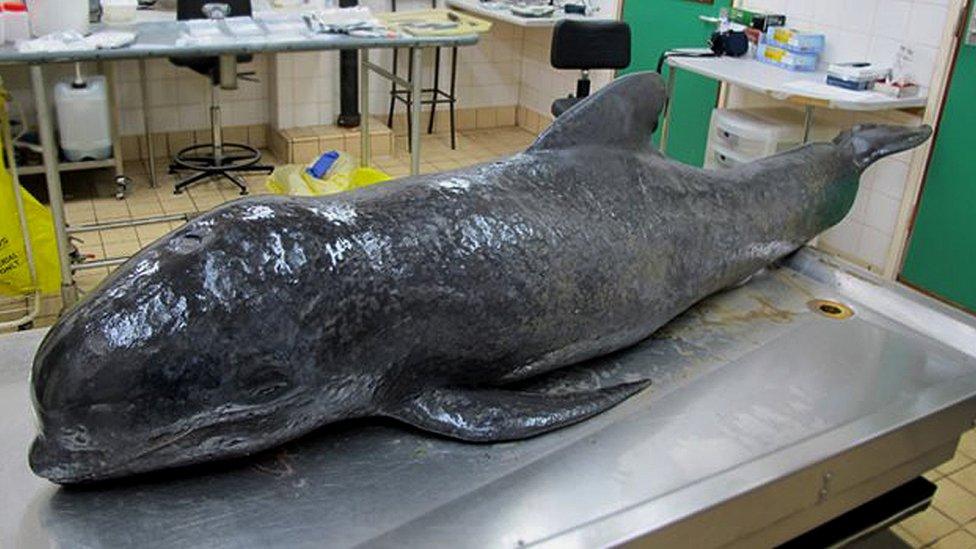
This female long-finned pilot whale was found on a beach near Goldhanger in Essex in 2014
"We don't examine everything," he says. "Quite a high proportion are too decomposed for a post-mortem examination."
The reason, he says, is that the blubber which keeps cetaceans warm in the seas and oceans makes for rapid decomposition on land - so much so that the insides of dead whales can be hot to the touch.
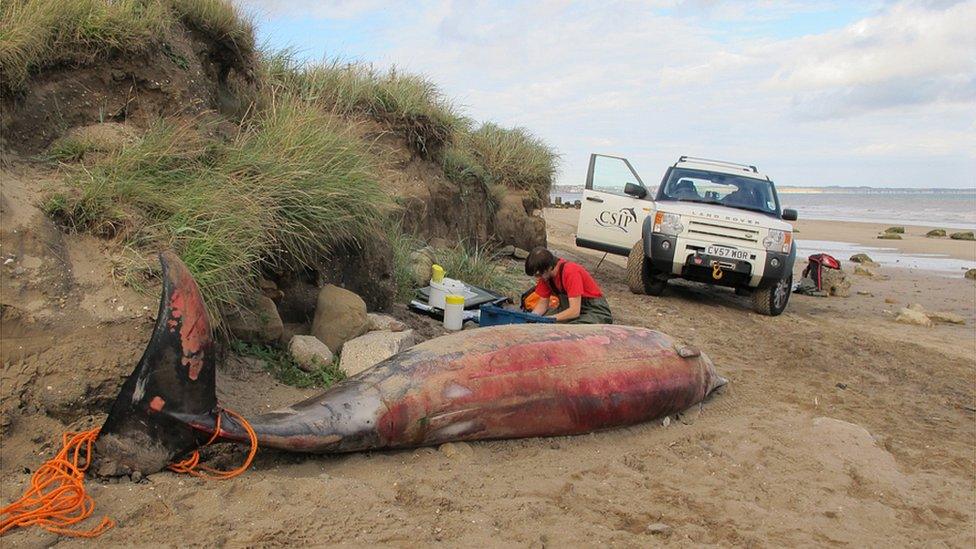
One of the Cetacean Strandings Investigation Programme team examining a dead whale
Having decided a cetacean is suitable for a post mortem, the next issue is one of logistics.
The team has a couple of vehicles capable of taking smaller cetaceans up to about 12ft (4m) long back to their London laboratory at the Institute of Zoology.
Larger creatures, however, have to be examined in situ.
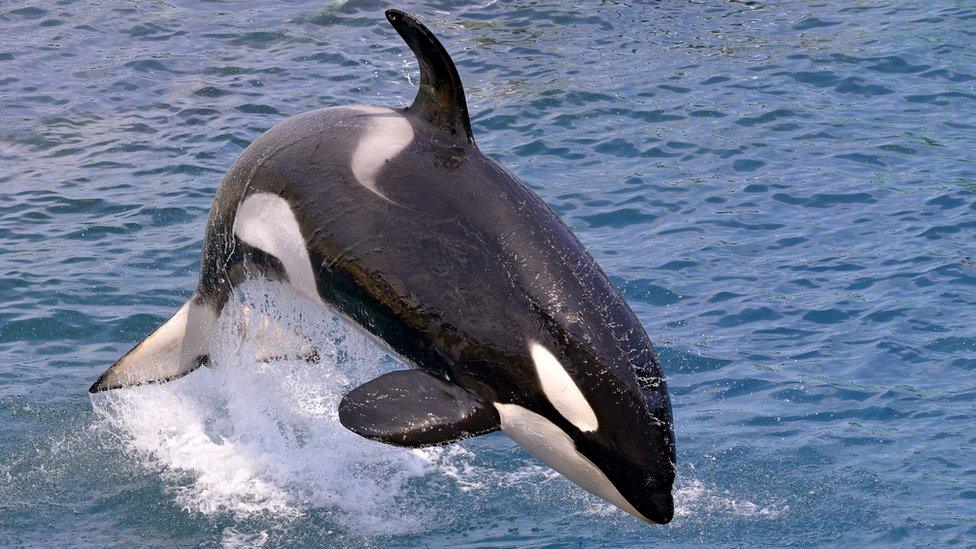
It was through post mortem examinations that the toxic effects of polychlorinated biphenyls (PCBs) on killer whales was first established
The post-mortem examination begins as it would with a human subject - the taking of photographs, recording any obvious physical signs of injury, trauma or possible disease and then a series of measurements.
"Then we open the body up," says Mr Deaville.
While a scalpel might work with humans, when it comes to whales a larger blade is required.
"We use a large knife called a flensing knife; it is the same type of knife that whalers use," he said. "We cut away the blubber and then open up the ribcage.
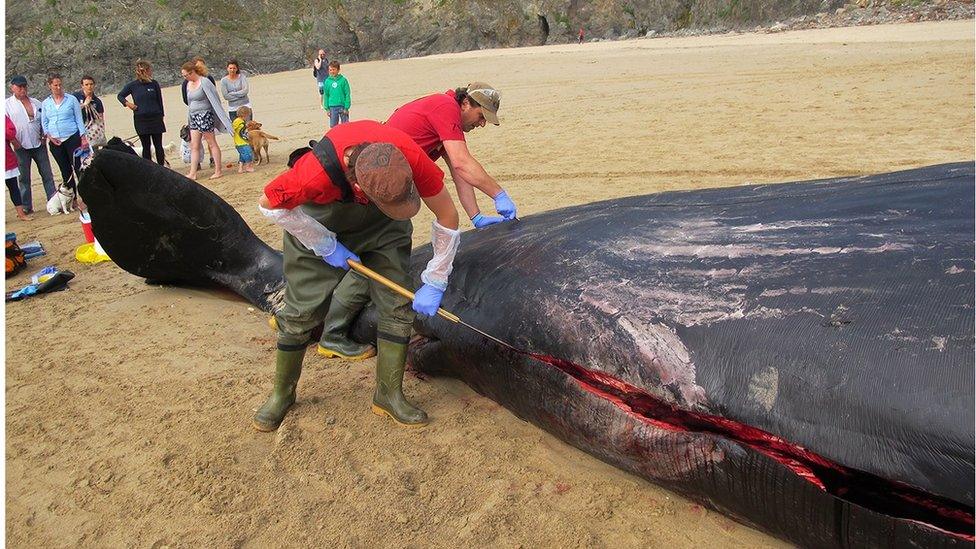
Large flensing knives are used for whale necropsies to cut through the skin and blubber of a whale
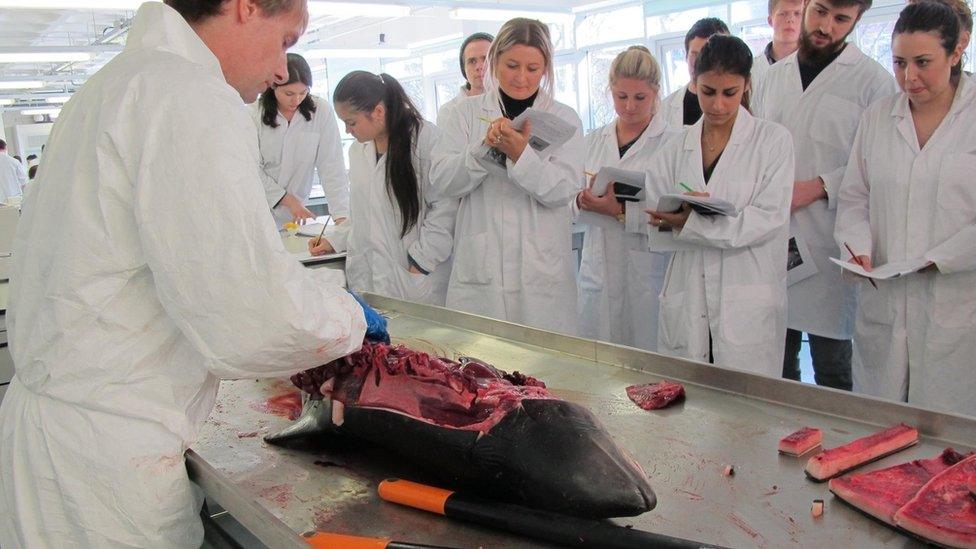
A demonstration post-mortem examination being carried out on a harbour porpoise at the University of Newcastle
"We then take out and examine each organ, sometimes using the winch on the 4x4 to remove parts of the whale," he said.
"At this stage we are looking for things outside the normal and taking samples from each organ.
"The blubber keeps it very warm inside... and warm or decomposing whales often prove pretty difficult to work with."
And occasionally extremely messy, Mr Deaville admits.
Earlier this year, his team was called to a sperm whale stranding on the east coast.
"It burst when we opened it," he said.
This was caused by gas inside the whale which, as a result of the heat caused by blubber insulation, had increased the pressure.
"But the best bit of kit we have," he said, "is our heads, which we use to try and establish the actual cause of a cetacean's death."

The winches on 4x4 vehicles are used to pull back skin and blubber from whales when necropsies are carried out in situ
During the post-mortem examination, the marine biologist will be trying to establish if the whale's death was caused by humans.
Parallel cuts, for example, are a telltale sign of ship-strike while other lesions can be evidence the animal has become entangled in fishing gear. Blunt trauma injuries can also be a sign of ship strike, Mr Deaville said.
A large bleed around a central point of trauma in a porpoise's blubber layer is usually a clear sign of attack by a bottle-nose dolphin, as is a certain type of bite mark, rib or spine fracture.
"Somebody actually filmed a bottlenose attack on a porpoise off Newlyn in Cornwall," says Mr Deaville, "but long before it was filmed we had discovered these attacks years before anybody witnessed it by carrying out post-mortem examinations.
"The post-mortem examinations we do on cetaceans can be more detailed than those done on humans.
"We will do virological (study of viruses), microbiological, histological (study of cells and tissues) and toxicological tests as standard because we are interested not just in how they died but in how they lived."
The range of tests and sample-taking is extensive.
Teeth, when cut through, have rings similar to trees, and thereby give an idea of age.
Gonadal material throws light on the cetacean's reproductive health, blubber thickness reflects the animal's general health while gut contents reveal much about a cetacean's diet. Samples include blood and body tissue, which are then stored in formalin or alcohol at subzero temperatures at the institute and can end up being sent to other institutions for research.

The death of 'skinny tail'

This fin whale was found washed up between the end of the sea wall at Burnham Overy and Holkham in Norfolk
In October, a whale was found washed up by wardens at the Holkham National Nature Reserve on the north Norfolk coast.
The evidence:
The whale was a juvenile female with an abnormal kink in its tail and body
There was a deep gash in the body-wall caused by a ship
Distortion was found in the spinal column
The conclusions:
The fin whale's demise is likely to have been triggered by a collision with a ship, which caused a large gash in its side and probably the spine damage
Because of its injuries, the whale would have struggled to dive to feed at depth, causing it to starve slowly
This starvation explains the slenderness of the tail and body. The wound also became infected, causing septicaemia

Once the necropsy has been carried out, there is the issue of disposal.
For those cetaceans examined in the London laboratory, the remains are collected by the local authority and sent off to landfill or for incineration.
By law, landowners in England and Wales are responsible for the disposal of whales, porpoises or dolphins that wash up on their estates. In the case of public beaches, disposal is the responsibility of the local council.
Because of the size of some cetaceans, disposal - which involves larger animals being cut up into more manageable chunks before they are taken away - can cost thousands of pounds, says Mr Deaville.
There is no doubt that cetacean necropsies are "gruesome", he says. Recalling one post-mortem examination he carried out on a whale in open air at Dawlish, he points out that they can also be very public - in this instance with passenger-laden trains passing close by at regular intervals.
But necropsies provide information about cetaceans that would be well nigh impossible to glean in any other way.
It was through post-mortem examinations that the toxic effects of polychlorinated biphenyls (PCBs) on killer whales were first established.
PCBs, which were once widely used in coolants and certain types of paper and paints, attack both the immune and reproductive system.
Killer whales used to be spotted in the mouth of the Thames and various parts of the UK.
Today, there are just eight inshore killer whales left in the UK, in north-west Scotland.
"That population will go extinct in our lifetime," Mr Deaville says.
Necropsies can also help identify previously unknown cetacean species, as happened after DNA tests were taken from a 24ft (7m) whale that washed up in Alaska, external in 2014.
Test results were compared with those taken from other strandings - and museum exhibits - that showed the whale was genetically removed from its nearest known relative.
Mr Deaville says: "Such discoveries are only known about through strandings and the necropsies done as a result."
As for Holkham's Ms Henderson, she just hopes the next whale she sees is a living one.
- Published20 October 2016

- Published26 January 2016
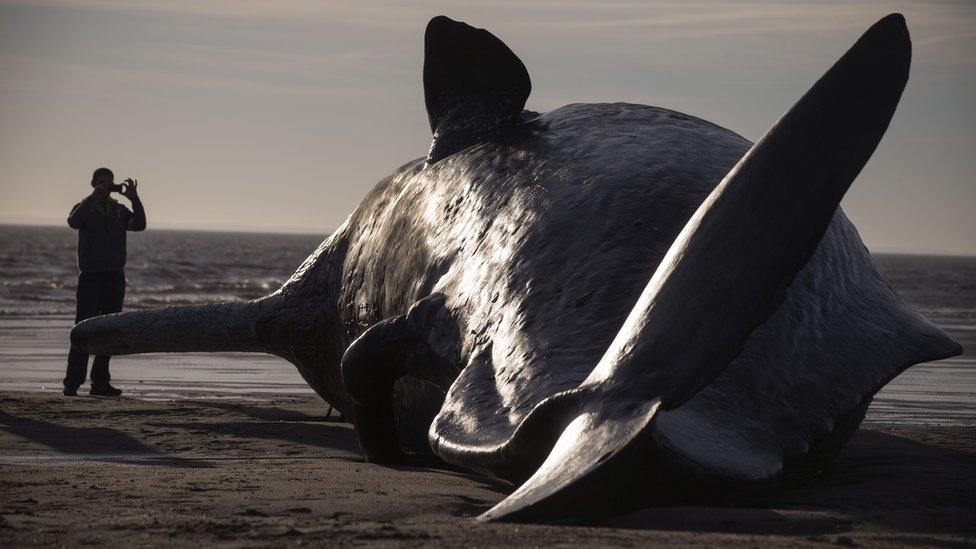
- Published8 March 2012
